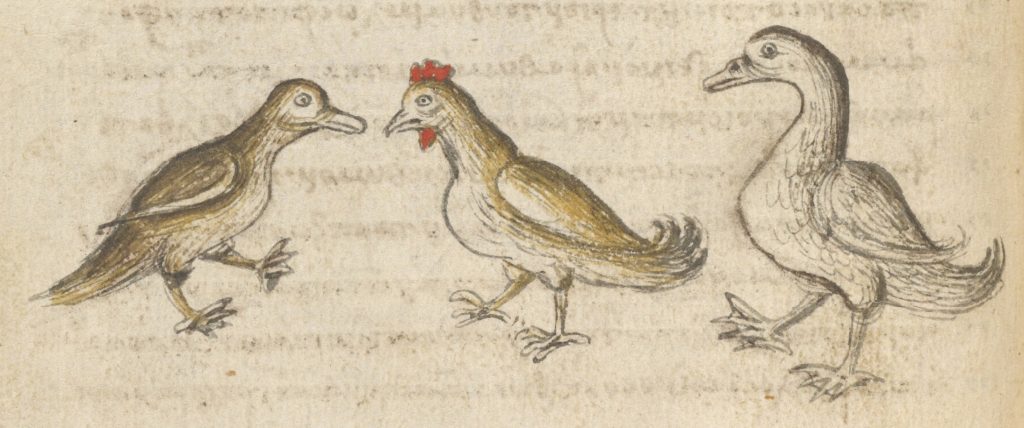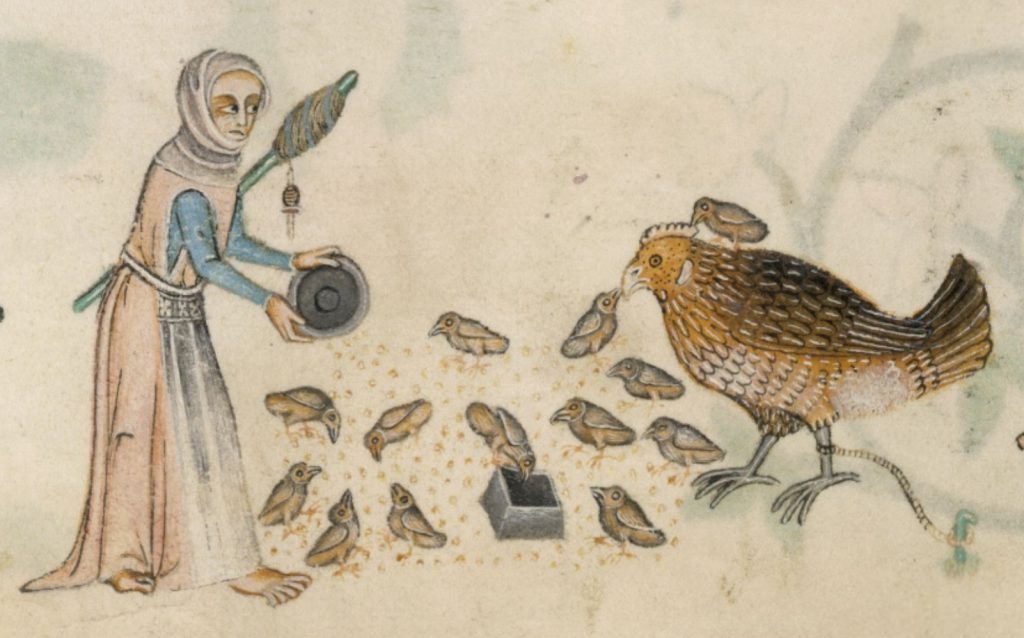
In the fable of The Goose with the Golden Eggs (Perry Index 87), the titular bird is killed by her foolish owner. This fable warns against seeking great, immediate gain over more modest, long-term gain—particularly when doing the former destroys a valuable, otherwise sustainable resource. The first extant version of this fable is that of Avianus, ca. 400 CE; earlier versions may have featured a hen rather than a goose, as fable scholar Francisco Rodríguez Adrados has argued on metrical grounds.1 But in Avianus, the creature is a goose, and so the tale was transmitted through the Middle Ages and beyond, becoming essentially proverbial.
As is the case with fable in general, medieval versions of The Goose with the Golden Eggs aim at providing a moral lesson to humans through a memorable extended metaphor. The plight of the bird who is killed in this story is not supposed to be the point. Nevertheless, below, I consider the real creatures behind the unrealistic analogy. Can we read the fable somewhat more subversively, as an admonition about the dangers of pushing animals beyond their physical limits?

Medieval and Modern Poultry
Chickens have long been kept for their eggs, at least as much as for their meat. Domestic geese, on the other hand, were valued in the Middle Ages mostly for their meat and feathers.2 Their flight feathers were used for quill pens and arrow fletching, amongst other things, while their down was used for insulation.3 When goose eggs did go on the market in the Middle Ages, though, they could be several times more expensive than hen eggs.4 Goose eggs are harder to come by; geese lay fewer eggs than chickens, and their strong pair-bonds make it infeasible to keep a flock with a very large ratio of laying females to males.5 Domestic geese nowadays might lay between 10 and 40 eggs a year, with the yield likely being somewhat lower than this in the Middle Ages;6 a medieval hen, however, might have laid as many as 100 eggs a year, or even more, “not far behind the level attained in the early twentieth century.”7
While domestic geese are still bred and raised for the resources their bodies provide, it is now predominantly chickens, “the most scientifically engineered of livestock,”8 whose eggs are the basis of an industry worth billions. A chicken bred for egg production can lay 300 eggs a year9—triple the rate of medieval chickens, or even early twenty-first century chickens. This high lay rate may be a cause for osteoporosis in the birds, exacerbated further by their inactivity when kept in “conventional” cages.10
The majority of the over 300 million “commercial laying hens” in the United States are housed in “conventional cage environments,” also known as battery farms. These birds are confined exclusively indoors, in tiers of stacked wire cages, several individuals in each cage, with eggs and waste collected via conveyor belts.11 This “convention” has only been widely implemented since the 1950s.12 Such systems were famously criticized by Ruth Harrison in an influential 1964 book, Animal Machines: The New Factory Farming Industry,13 and since then, “factory farming” has only become further entrenched as a normative practice. In 2009, about 95% of commercial laying hens in the US were in “conventional” cages.14 That percentage has dropped to around 66% as of 2022,15 and is continuing to drop; battery cages were outlawed in the European Union in 2012, and are being outlawed in a growing number of US states, because of animal welfare concerns.

Medieval Fables of Golden Geese
Medieval versions of the fable of The Goose with the Golden Eggs imagine that there are firm natural limits to the bird’s production of precious gold eggs, which cannot be exceeded. “Nature had fixed this law for the magnificent bird, that she was not permitted to bear two gifts at the same time,” says Avianus’s Latin verse version (fixerat hanc volucri legem Natura superbae, / ne liceat pariter munera ferre duo, lines 3-4).16 In Avianus’s telling, the goose’s owner is portrayed as impatient and calculating—he is concerned that the “gifts” won’t last and eager to maximize profit from her body:
sed dominus, cupidum sperans vanescere votum,
non tulit exosas in sua lucra moras,
grande ratus pretium volucris de morte referre,
quae tam continuo munere dives erat. (lines 5–8)
(But the master, expecting the greedy offering to disappear, did not endure odious delays to his profits, and thought to withdraw from the death of the bird great value, who had been so continuously rich with gifts).
Upon killing the bird and finding her body devoid of treasure, he considers himself deservedly punished by the gods for his own avarice; the fable’s moral concludes:
sic qui cuncta deos uno male tempore poscunt,
iustius his etiam vota diurna negant. (lines 13–14)
(So, to those who wrongly demand from the gods everything at once, they deny even daily prayers more justly.)
A late medieval Middle English prose version of the fable, in William Caxton’s Aesop (1484), tells the story somewhat differently: the goose’s greedy owner verbally commands her to lay two eggs a day instead of one, and kills her, out of anger, when she protests that she can’t. Caxton’s moral is less pithy, but still expresses the sentiment that the man has only hurt his own interests by killing the goose.
The man of auaryce or couetousnes commaunded and bad to her/ that euery daye she shold leye two egges/ And she sayd to hym/ Certaynly/ my mayster I maye not/ wherfore the man was wrothe with her/ and slewe her/ wherfore he lost that same grete good/ of the whiche dede he was moche sorowful and wrothe/ how be it that it was not tyme to shette the stable whan the horses ben loste/ & gone/ And he is not wyse/ whiche dothe suche a thinge/ wherof he shalle repente hym afterward/ ne he also/ whiche doth his owne dommage for to auenge hym self on somme other/ For by cause that he supposeth to wynne al/ he leseth all that he hath17
(The man, out of avarice or covetousness, commanded and ordered that every day she must lay two eggs. And she said to him, “Truly, my master, I cannot,” and so the man was angry with her and killed her, and so he lost that same great benefit, of which deed he was very sad and angry. Nevertheless, it is too late to shut the stable when the horses are lost and gone, and he is not wise who does something that he will regret afterward, nor is he wise who does himself harm to avenge himself on someone else. For, because he intends to gain everything, he loses all that he has.)
Authors like Avianus and Caxton did not foresee the drastic “improvements” that domesticated birds would undergo through breeding, or the battery farms that would house them nearly immobile in tiny cages, with the aim of maximizing profit. “Today,” says Margaret E. Derry, “we use chickens in a more mechanistic way than all other farm livestock. We follow practices that are not good for the birds and do not necessarily reflect well on us, in spite of the obvious benefits of such practices” (i.e., cheap eggs for human consumption).18 The morals to the two medieval versions of The Goose with the Golden Eggs that I considered above ultimately frame the bird’s violent demise in terms of how this impacts the human killer financially; we are encouraged to view the slaughter as, above all, unwise, because the goose was profitable to her owner, rather than as an act of cruelty or injustice toward the victim. But despite these mercenary morals, the fables’ authors nevertheless presciently suggest that human greed can demand more of animals than they can provide us, and that this is destructive, to them and to us.
- Francisco Rodríguez Adrados, The History of the Graeco-Latin Fable (Brill, 2003), vol. 3, p. 113. ↩︎
- Philip Slavin, “Goose management and rearing in late medieval eastern England, c.1250–1400,” The Agricultural History Review, vol. 58, no. 1 (2010), p. 4. ↩︎
- Dale Serjeantson, “Goose husbandry in Medieval England, and the problem of ageing goose bones,” Acta zoologica cracoviensia, vol. 45 (2002), p. 43. ↩︎
- Slavin, “Goose management and rearing,” p. 8. ↩︎
- Serjeantson, “Goose husbandry in Medieval England,” p. 41. ↩︎
- Slavin, “Goose management and rearing,” p. 16. ↩︎
- D. J. Stone, “The Consumption and Supply of Birds in Late Medieval England,” in Food in Medieval England: Diet and Nutrition, ed. C. M. Woolgar, D. Serjeantson, and T. Waldron (Oxford University Press, 2006), p. 154. ↩︎
- Margaret E. Derry, Art and Science in Breeding: Creating Better Chickens (University of Toronto Press, 2012), p. 4. ↩︎
- United Egg Producers, “Facts & Stats,” accessed January 4, 2025. ↩︎
- C. C. Whitehead et al., “Osteoporosis in cage layers,” Poultry Science, vol. 79, 7 (2000), 1033–1041; A. B. Webster, “Welfare implications of avian osteoporosis,” Poultry Science, vol. 83, 2 (2004): 184–92. ↩︎
- United Egg Producers, “Hen Housing Diagrams,” accessed January 4, 2025. ↩︎
- B. Yilmaz Dikmen et al., “Egg production and welfare of laying hens kept in different housing systems (conventional, enriched cage, and free range),” Poultry Science, vol. 95, 7 (2016), p. 1564. ↩︎
- Ruth Harrison, Animal Machines (Vincent Stuart Publishers, 1964). Reprinted with new commentaries 2013 by CAB International. ↩︎
- Sara Shields and Ian J. H. Duncan., “A Comparison of the Welfare of Hens in Battery Cages and Alternative Systems” (2009), Impacts on Farm Animals 18, WellBeing International, accessed January 4, 2025. ↩︎
- United Egg Producers, “Facts & Stats,” accessed January 4, 2025. ↩︎
- Latin text from J. Wright Duff and A. M. Duff, eds., Minor Latin Poets, Volume II: Florus, Hadrian, Nemesianus, Reposianus, Tiberianus, Dicta Catonis, Phoenix, Avianus, Rutilius Namatianus, Others, Loeb Classical Library (Cambridge: Harvard University Press, 1934), p. 732. All modern English translations in this post are my own. ↩︎
- Middle English text from R. T. Lenaghan, ed., Caxton’s Aesop, Edited with an Introduction and Notes (Cambridge: Harvard University Press, 1967), p. 190. ↩︎
- Derry, Art and Science in Breeding, p. 9. ↩︎





